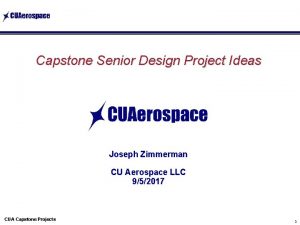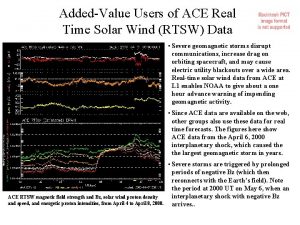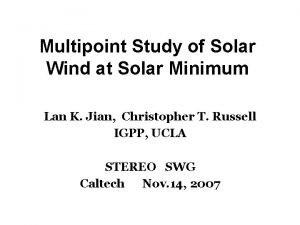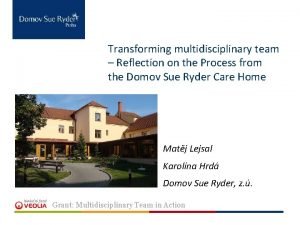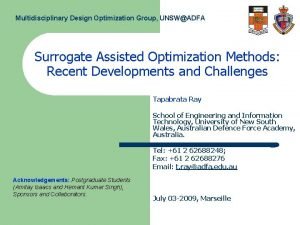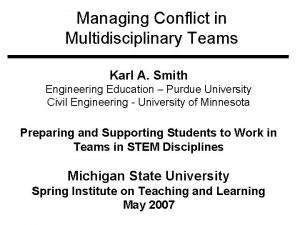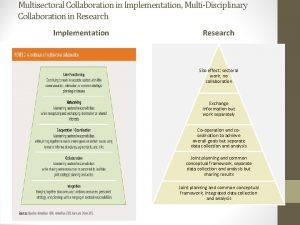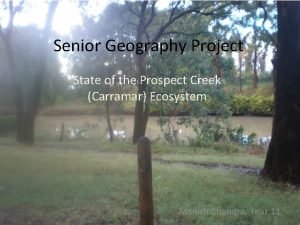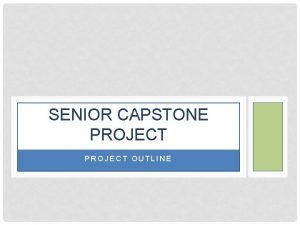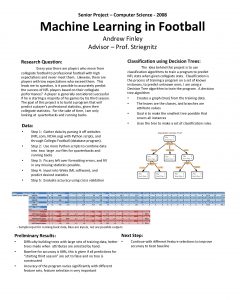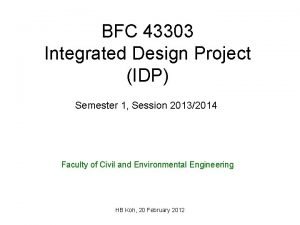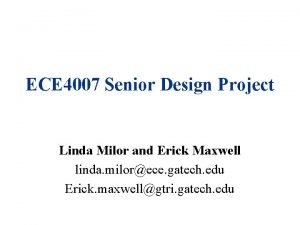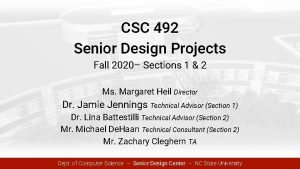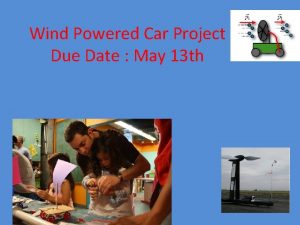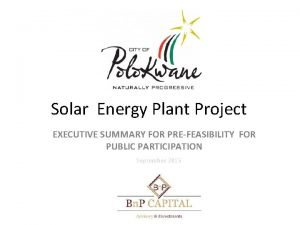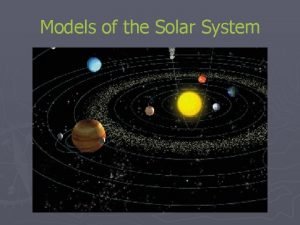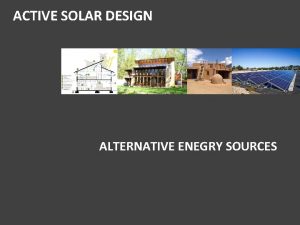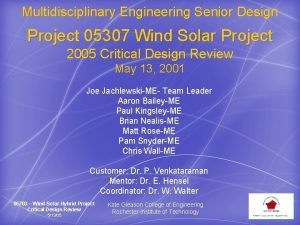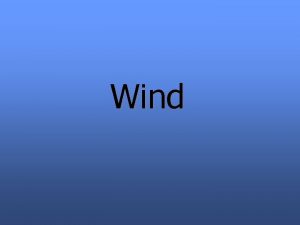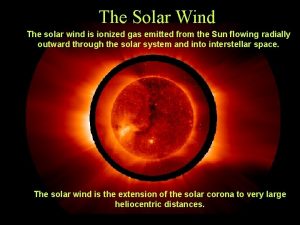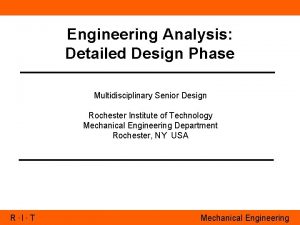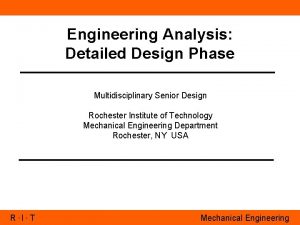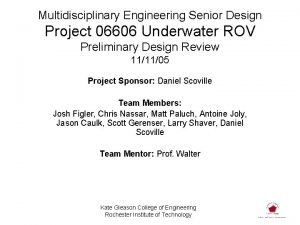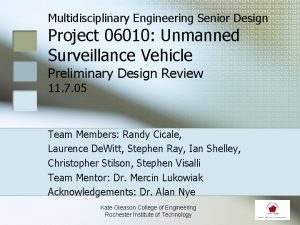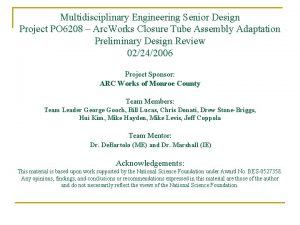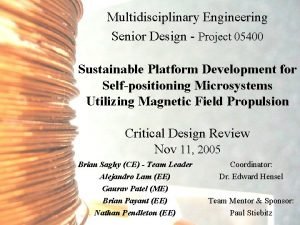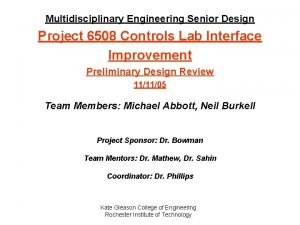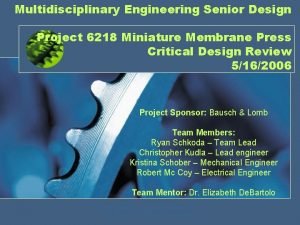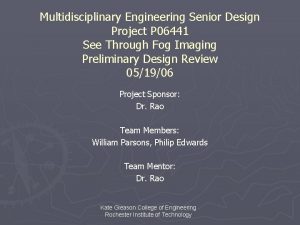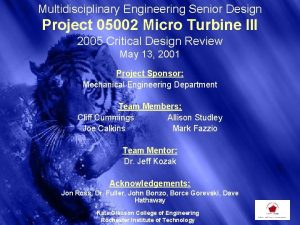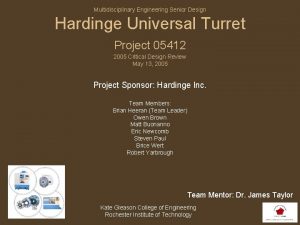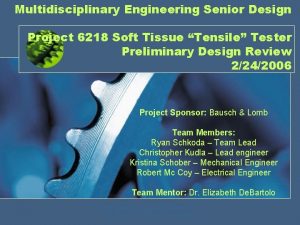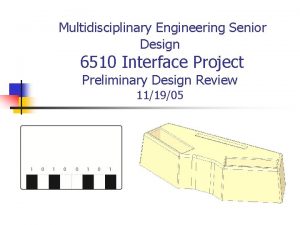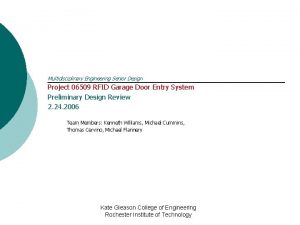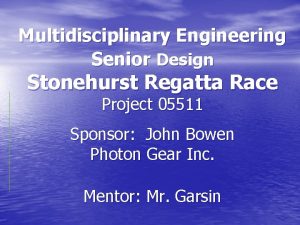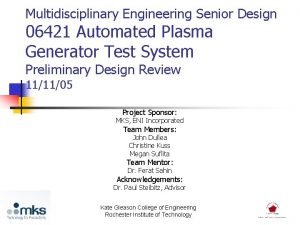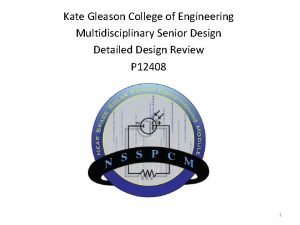Multidisciplinary Engineering Senior Design Project 05307 Wind Solar








































- Slides: 40

Multidisciplinary Engineering Senior Design Project 05307 Wind Solar Project 2005 Critical Design Review May 13, 2001 Joe Jachlewski-ME- Team Leader Aaron Bailey-ME Paul Kingsley-ME Brian Nealis-ME Matt Rose-ME Pam Snyder-ME Chris Wall-ME Customer: Dr. P. Venkataraman Mentor: Dr. E. Hensel Coordinator: Dr. W. Walter 05703 – Wind-Solar Hybrid Project Critical Design Review 5/13/05 Kate Gleason College of Engineering Rochester Institute of Technology

Project Background § § § Recent push for “green” power sources NYSERDA Proposal The long-term goal of this project is to create a marketable wind/solar hybrid power generation system that can be applied to outdoor lighting and other applications. 05703 – Wind-Solar Hybrid Project Critical Design Review 5/13/05 Kate Gleason College of Engineering Rochester Institute of Technology

Mission Statement The mission of the 2004 -2005 Wind Solar Team is to design and build a prototype of an outdoor lighting system that is powered solely by wind and solar energy. The team will test the prototype for a minimum of one week and evaluate the system performance. The prototype will be safe and easy to modify. 05703 – Wind-Solar Hybrid Project Critical Design Review 5/13/05 Kate Gleason College of Engineering Rochester Institute of Technology

Desired Outcomes § Safe operation § Integration of wind turbine, solar panel, a light, an energy storage system, support structures, and signal processing equipment. § Ability for Turbine interchangeability for future testing 05703 – Wind-Solar Hybrid Project Critical Design Review 5/13/05 Kate Gleason College of Engineering Rochester Institute of Technology

Key Requirements & Critical Parameters § § § Complete first design Build first prototype Test prototype for at least a week Evaluate system performance Provide recommendations for future designs Power the light 05703 – Wind-Solar Hybrid Project Critical Design Review 5/13/05 Kate Gleason College of Engineering Rochester Institute of Technology

Design Process Project Definition Build Prototype System Testing and Evaluation 05703 – Wind-Solar Hybrid Project Critical Design Review 5/13/05 Feasibility Assessment Concept Development Analysis & Synthesis of Design Preliminary Prototype Design Future Recommendations Kate Gleason College of Engineering Rochester Institute of Technology

Concept Development 05703 – Wind-Solar Hybrid Project Critical Design Review 5/13/05 Kate Gleason College of Engineering Rochester Institute of Technology

Concept Development 05703 – Wind-Solar Hybrid Project Critical Design Review 5/13/05 Kate Gleason College of Engineering Rochester Institute of Technology

Feasibility Assessment Required size of the power generation system 05703 – Wind-Solar Hybrid Project Critical Design Review 5/13/05 Total power required for each concept Kate Gleason College of Engineering Rochester Institute of Technology

Feasibility Assessment Strengths Weaknesses Concept A Light output comparable to existing Power generation system size too large outdoor area lighting. for self-contained design. Cost of power generation and storage exceeds budget. Concept B Light output comparable to existing Power generation system size too large outdoor area lighting. for self-contained design. Cost of power generation and storage exceeds budget. Concept C Power generation system size lends Expected light output less than existing itself to self-contained design. outdoor area lighting. Cost of power generation system and storage within budget. Concept C was selected for further design. 05703 – Wind-Solar Hybrid Project Critical Design Review 5/13/05 Kate Gleason College of Engineering Rochester Institute of Technology

Synthesis of Design § Light Selection Manufactured by: Color: Warm White Diameter: 4. 80” Height: 4. 76” Current: 76 m. A Wattage: 9. 2 W Brightness: >43000 LUX Nominal Current: 20 m. A Nominal Voltage: 3. 0~3. 6 V 05703 – Wind-Solar Hybrid Project Critical Design Review 5/13/05 Light Waves Concepts Par 38 120 LED Kate Gleason College of Engineering Rochester Institute of Technology

Synthesis Of Design Power Generation System Design Space Design Point *Based on a 20 Watt power requirement and a 15 % efficient turbine 05703 – Wind-Solar Hybrid Project Critical Design Review 5/13/05 Kate Gleason College of Engineering Rochester Institute of Technology

Synthesis of Design § Solar Panel Selection Model #: BP SX 10 Maximum power: 10 W Warranted power: 9 W Voltage at maximum power: 16. 8 V Open-circuit voltage: 21. 0 V Current at maximum power: 0. 59 A Short-circuit current: 0. 65 A 12 year Warranty for 90% output 05703 – Wind-Solar Hybrid Project Critical Design Review 5/13/05 Kate Gleason College of Engineering Rochester Institute of Technology

Synthesis of Design § Wind Turbine Design – Savonius Turbine – 1. 46 m 2 swept area – Assuming 15 % efficiency, theoretical 13 Watt mechanical power production – Two-stage, gapless, constructed with 0º/90º woven E-glass and epoxy – PVC central shaft *A tubular rib was added to increase the stiffness of the top and bottom plates 05703 – Wind-Solar Hybrid Project Critical Design Review 5/13/05 Kate Gleason College of Engineering Rochester Institute of Technology

Analysis of Turbine Deflection without supporting ribs Deflection with supporting ribs *Under gravitational loading 05703 – Wind-Solar Hybrid Project Critical Design Review 5/13/05 Kate Gleason College of Engineering Rochester Institute of Technology

Synthesis of Design § Generator Selection and Calibration Current-Torque Calibration – Donated by team member – 40 VDC nominal Voltage-RPM Calibration *The motor was manufactured by Ametek, and is currently out of production, so motor specifications were not available from the manufacturer. 05703 – Wind-Solar Hybrid Project Critical Design Review 5/13/05 Kate Gleason College of Engineering Rochester Institute of Technology

Synthesis of Design § Energy storage – Minnkota Sealed Lead Acid Dual Purpose – Nominal Voltage: 12 Volts – Capacity: 72 Ah (at 20 hr rate) – Recommended charging voltage: 12. 4 Volts – Internal Resistance: 0. 17 Ohms – Supply power to the light for 3 -5 days 05703 – Wind-Solar Hybrid Project Critical Design Review 5/13/05 § Electrical Conditioning – 12 VDC to 120 VAC inverter (purchased) – DC step up circuit – DC voltage leveling charge pump was purchased for charging the SLA battery. Kate Gleason College of Engineering Rochester Institute of Technology

Analysis and Synthesis of Design Support Structures § Stationary Shaft § Wood Post – 6”x 16’ Pressure treated lumber – 2” Aluminum Rod Stock – 6’ long – safety factor of 3. 3 – safety factor of 4. 60 = 47. 17 MPa 05703 – Wind-Solar Hybrid Project Critical Design Review 5/13/05 Kate Gleason College of Engineering Rochester Institute of Technology

Synthesis of Design § Drive Train – 1: 1 Gear Ratio Selection § To maximize efficiency of the turbine Gears Stationary Shaft Chain Rotating Bearing Collar Generator Adaptor Stationary Shaft Mount Generator Mount Chain Tensioner 05703 – Wind-Solar Hybrid Project Critical Design Review 5/13/05 Kate Gleason College of Engineering Rochester Institute of Technology

Final Design § Installed April 27 th and still operating § Insert video 100_0417 05703 – Wind-Solar Hybrid Project Critical Design Review 5/13/05 Kate Gleason College of Engineering Rochester Institute of Technology

Testing and trouble shooting § § § What we observed What changes were made What we measured Desired vs. Actual Outcomes What we learned 05703 – Wind-Solar Hybrid Project Critical Design Review 5/13/05 Kate Gleason College of Engineering Rochester Institute of Technology

What we observed… § The chain was loose and the gear offset was wobbly - the chain fell off the gear § The top and bottom plates on the turbine fractured and caused vibration problems § Bolts became loose due to the unanticipated vibrations § Power generation from the turbine was significantly lower than expected 05703 – Wind-Solar Hybrid Project Critical Design Review 5/13/05 Kate Gleason College of Engineering Rochester Institute of Technology

What we changed… § Machined a new gear offset with tighter tolerances § Added a chain tensioner § Modified the turbine to minimize vibrations (with the help of the wind) § Added Locktite to all bolts and screws § Disconnected generator from charging system as a trouble shooting measure 05703 – Wind-Solar Hybrid Project Critical Design Review 5/13/05 Kate Gleason College of Engineering Rochester Institute of Technology

What we measured… 05703 – Wind-Solar Hybrid Project Critical Design Review 5/13/05 Kate Gleason College of Engineering Rochester Institute of Technology

§ Desired Outcomes 05703 – Wind-Solar Hybrid Project Critical Design Review 5/13/05 § Actual Outcomes Kate Gleason College of Engineering Rochester Institute of Technology

Conclusions - What we learned… 05703 – Wind-Solar Hybrid Project Critical Design Review 5/13/05 Kate Gleason College of Engineering Rochester Institute of Technology

Recommendations for Improvement § § § § Generator should be optimized for lower speeds Use DC LED array Locking nuts should be used in the event of vibrations in high winds Permanently seal the battery box and generator protective case. Use a stiffer material for the turbine Higher quality anemometer Permanent weather proof data logger System should be optimized for overall system efficiency, not just turbine efficiency 05703 – Wind-Solar Hybrid Project Critical Design Review 5/13/05 Kate Gleason College of Engineering Rochester Institute of Technology

Opportunities for Future Research § Obtain values for the amount of sunlight incident on the ground § Illuminance map for the LED light source § Other turbine configurations should be tested. § Engineering Economics for changing to autonomous system § Predict the life of the system § Predict the year-round performance § Develop a comprehensive system model 05703 – Wind-Solar Hybrid Project Critical Design Review 5/13/05 Kate Gleason College of Engineering Rochester Institute of Technology

For a Marketable Product… § Solar Panel and Turbine size need to be optimized based on cost, aesthetics, and size § Stronger, more durable materials should be used for the turbine § Power generation system incorporated into a permanent lighting structure § Design for Manufacture, Profitability, Maintenance and Performance § A final market must be selected § Environmental impact study 05703 – Wind-Solar Hybrid Project Critical Design Review 5/13/05 Kate Gleason College of Engineering Rochester Institute of Technology

Team Accomplishments § Designed, developed and built a prototype § The prototype was installed 2 and a half weeks ago, which allowed ample time for debugging the systems and learning more about the systems. § Provided accurate documentation of recommendations for future development § Came in under budget and on time - we spent $1600 out of the available $3000. § Completed comprehensive background research that would be invaluable for future teams § Developed a design space representing the tradeoffs between turbine size and solar panel size 05703 – Wind-Solar Hybrid Project Critical Design Review 5/13/05 Kate Gleason College of Engineering Rochester Institute of Technology

Acknowledgements § Dr. Hensel for his invaluable guidance and mentoring § Dr. Venkataraman for his initial concept and continued input throughout the project § Dave Hathaway and Steve Kosciol – Machining and Part ordering assistance § John Wellin – assistance with the DAQ system § Dave Harris and the rest of Facilities Management Services for their support throughout the installation process § Electrical help was provided by Dr. Wayne Walter, Dr. Daniel Phillips, and Dr. David Borkholder. § Joel Slavis from Light Waves Concept, Inc provided the LED arrays at a discount. 05703 – Wind-Solar Hybrid Project Critical Design Review 5/13/05 Kate Gleason College of Engineering Rochester Institute of Technology

References 1. B. F. Blackwell, R. E. Sheldahl, and L. V. Feltz. “Wind Tunnel Performance Data for Two- and Three- Bucket Savonius Rotors. ” Sandia Laboratories. SAND 76 -0131. (July 1977). 05703 – Wind-Solar Hybrid Project Critical Design Review 5/13/05 Kate Gleason College of Engineering Rochester Institute of Technology

Questions 05703 – Wind-Solar Hybrid Project Critical Design Review 5/13/05 Kate Gleason College of Engineering Rochester Institute of Technology

Torque for 1, 2 and 3 stage turbines 05703 – Wind-Solar Hybrid Project Critical Design Review 5/13/05 Kate Gleason College of Engineering Rochester Institute of Technology

Cost Assessment § § Budget= $3000 Epoxy: $140 per m 2 Solar Panels: $5. 40 per Watt Battery: $0. 08 per Watt-Hour Concept A Concept B Concept C 05703 – Wind-Solar Hybrid Project Critical Design Review 5/13/05 Cost $9820 $3910 $189 Kate Gleason College of Engineering Rochester Institute of Technology

Power Production Vs. Consumption 05703 – Wind-Solar Hybrid Project Critical Design Review 5/13/05 Kate Gleason College of Engineering Rochester Institute of Technology

Project Plan for SD 2 05703 – Wind-Solar Hybrid Project Critical Design Review 5/13/05 Kate Gleason College of Engineering Rochester Institute of Technology

Power available from the wind for various wind speeds and efficiencies. 05703 – Wind-Solar Hybrid Project Critical Design Review 5/13/05 Kate Gleason College of Engineering Rochester Institute of Technology

Power Produced vs. Power Consumed 05703 – Wind-Solar Hybrid Project Critical Design Review 5/13/05 Kate Gleason College of Engineering Rochester Institute of Technology

Post Anchoring § Strong but temporary § The base of the post is buried 3’ in a 1’ diameter hole, which is filled with cement. § Additional guy wires were anchored into 5 gallon buckets filled with cement and buried 1 foot deep § This provided restraints on the pole to ensure that it will not fall down. § After testing the cement segments can be dug up and the whole system can be relocated to the engineering test area 05703 – Wind-Solar Hybrid Project Critical Design Review 5/13/05 Kate Gleason College of Engineering Rochester Institute of Technology
 Multidisciplinary software development team
Multidisciplinary software development team Ee senior design project ideas
Ee senior design project ideas Kurshalter
Kurshalter Ace rtsw
Ace rtsw Wind energy is an indirect form of
Wind energy is an indirect form of Solar wind
Solar wind Whosale solar
Whosale solar Inexhaustible source of energy
Inexhaustible source of energy Uksn almora
Uksn almora Multidisciplinary team pros and cons
Multidisciplinary team pros and cons Multidisciplinary
Multidisciplinary Multidisciplinary vs interdisciplinary
Multidisciplinary vs interdisciplinary Transdisciplinary vs interdisciplinary
Transdisciplinary vs interdisciplinary Sunderlal bahuguna quotes in malayalam
Sunderlal bahuguna quotes in malayalam Conflict in multidisciplinary teams
Conflict in multidisciplinary teams Multisectoral and multidisciplinary
Multisectoral and multidisciplinary Interdisciplinary multidisciplinary transdisciplinary
Interdisciplinary multidisciplinary transdisciplinary Epcc degree plans
Epcc degree plans Final project presentation template
Final project presentation template Senior project outline
Senior project outline Senior geography project
Senior geography project Capstone proposal outline
Capstone proposal outline Senior exit project ideas
Senior exit project ideas Machine learning senior project ideas
Machine learning senior project ideas Integrated design project civil engineering
Integrated design project civil engineering Ucf senior design
Ucf senior design Ece senior design gatech
Ece senior design gatech Ncsu csc senior design
Ncsu csc senior design Wind powered car project
Wind powered car project Executive summary for solar project
Executive summary for solar project Organizational development proposal presentation
Organizational development proposal presentation Sindh solar energy project
Sindh solar energy project Solar village project
Solar village project Aristarchus model
Aristarchus model Tip speed formula
Tip speed formula Wind turbine blade design
Wind turbine blade design Active solar design
Active solar design What is system in software engineering
What is system in software engineering Forward engineering in software engineering
Forward engineering in software engineering Dicapine
Dicapine Engineering elegant systems: theory of systems engineering
Engineering elegant systems: theory of systems engineering

